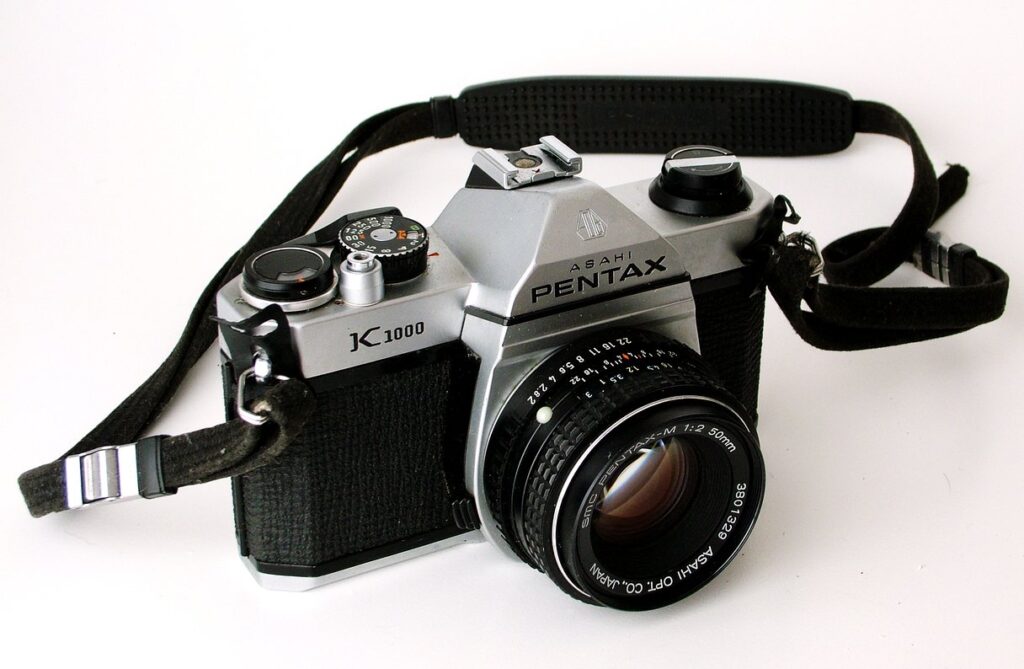The Pentax K1000 is more than just a camera; it’s a symbol of the enduring simplicity and reliability that defined analog photography. For decades, this single-lens reflex (SLR) model has been cherished by photographers from beginners to seasoned professionals. This article delves into the history, distinctive features, and special qualities that set the K1000 apart from other legendary analog cameras like the Leica M series, Hasselblad medium-format models, and the Contax G2.
The History of the Pentax K1000
Introduced in 1976 by Asahi Optical Co. (later Pentax Corporation), the Pentax K1000 quickly became synonymous with durability and straightforward operation. It was designed during a period when the photography market was evolving, embracing more automated models while still maintaining manual mastery. The K1000 emerged as an accessible, affordable, and dependable option that appealed to photography students and enthusiasts who valued full manual control.
The K1000’s reign extended for over 20 years until 1997, making it one of the longest continuously produced SLRs in history. Its legacy is tied to its role as an educational tool in photography courses worldwide, where its simplicity encouraged students to understand the fundamentals of exposure, focusing, and composition.
Key Features That Define the Pentax K1000
- Fully Manual Operation: The K1000 operates without automation, giving photographers complete control over exposure settings. This made it an excellent tool for learning the basics of photography, fostering skills that could be applied to more advanced techniques.
- Built-in Light Meter: While the K1000 is manual, it features a built-in CdS light meter powered by a 1.5V battery, simplifying exposure adjustments by indicating whether the settings align with correct exposure levels.
- Durability: Constructed with a robust metal body (later transitioning to a mix of metal and plastic), the K1000 was built to last. This resilience is a significant reason why so many units remain functional and sought after by collectors today.
- Pentax K-Mount Compatibility: The K1000’s bayonet lens mount provides access to a wide array of Pentax lenses, including the highly regarded SMC (Super Multi-Coated) lenses known for their excellent sharpness and contrast.
- Simplicity and Ease of Use: With just a handful of controls—shutter speed, aperture, and film advance lever—the K1000 is intuitive. Its minimalistic design is free from distractions, allowing photographers to focus purely on composition and technique.
What Makes the Pentax K1000 Special?
The K1000’s simplicity is perhaps its most defining trait. Unlike models such as the Leica M series, renowned for their precise rangefinder mechanisms and luxurious craftsmanship, the K1000 is the epitome of no-frills practicality. The Leica’s allure lies in its unparalleled build quality and the exclusivity of its optics, while the K1000 democratized photography, making high-quality results achievable for everyone.
When compared to medium-format giants like Hasselblad, known for their stunning image quality and modular systems, the K1000’s advantage lies in its accessibility and portability. It offered the ability to explore 35mm film photography without the complexity or cost associated with larger format cameras.
Against a more technologically advanced model like the Contax G2, which boasted features such as autofocus and electronic exposure controls, the K1000 represents the charm of mastering photography through manual control. It remains an excellent choice for those who relish a hands-on, tactile shooting experience.
The Pentax K1000 in the Collector’s Market
Today, the Pentax K1000 holds a revered place in the collector’s market. Its long production life means there are many units available, yet those in pristine condition, complete with original accessories, are especially prized. Collectors often seek models from the earliest production runs, identifiable by their all-metal construction and Japanese manufacturing.
This enduring interest can be attributed to the camera’s reputation for reliability and its significance in the history of photography education. It’s not uncommon to find a well-cared-for K1000 still functioning perfectly, decades after its production, a testament to its build quality.
Conclusion
The Pentax K1000 is more than just an analog camera; it’s a photographic legend. Its straightforward, reliable design continues to attract those who value mastering the art of manual photography. Whether you’re a collector who appreciates its historical importance or a photographer seeking a dependable tool to connect with the roots of the craft, the K1000 stands as a reminder that simplicity and functionality can create a legacy that lasts generations.

